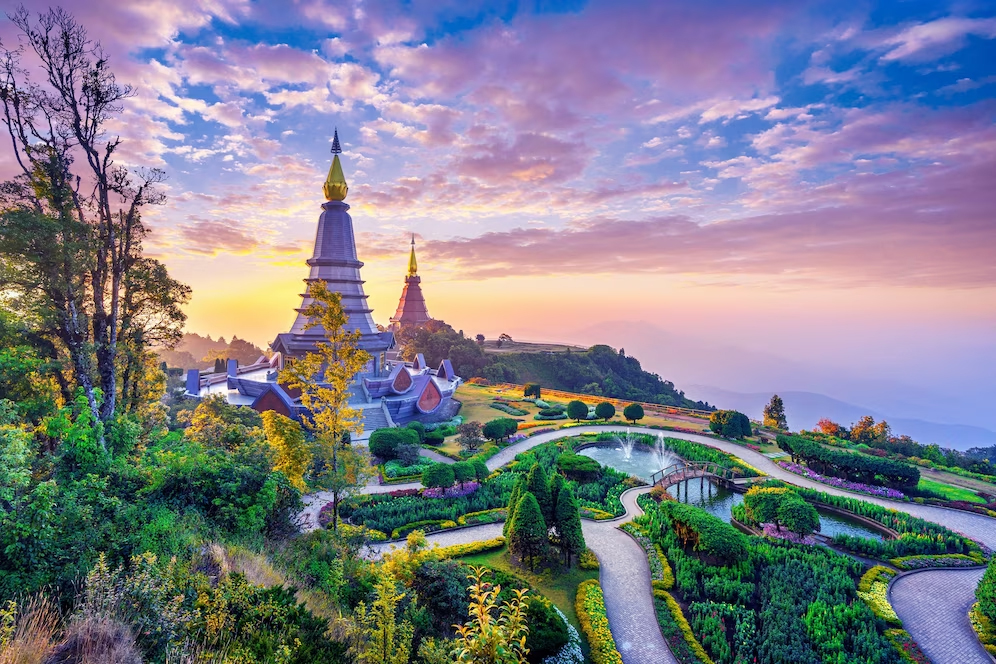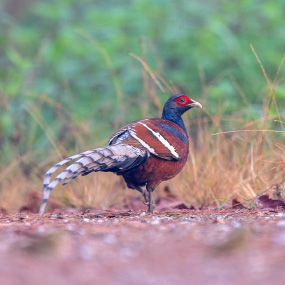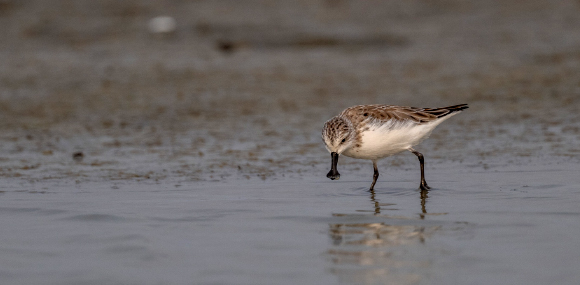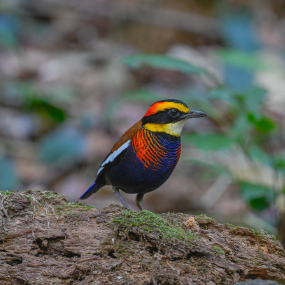Destinations
Destinations by regions
Central Thailand

Bangban, Ayuthaya Province:
The open field of rice paddies and aquaculture ponds where is the most popular for Pied Kingfisher photograph. Simply settle down yourself behind the local restaurant, Krua Manao, you can get the best shots of different actions of Pied Kingfisher up close.Suan Rot Fai Park, Bangkok:
>One of the most popular spots for bird photographers in the middle of Bangkok. It is quite an easy and likable place for taking a bird in flight in a very busy Thailand metropolitan. Iconic species here include Spotted Owlet and Asian Barred Owlet.Khao Yai National Park:
The country first national park and now a UNESCO World Heritage Site. It is the most popular and most visited park in Thailand as it located not far from Bangkok. The park holds variety of spectacular habitats and tourist attractions worth visiting. It is easy to access and explore with neat paved roads go through many interesting spots all over the park. Tourist facilities in the park are excellent too.Some of birds photography hot spots in the park such as a viewpoint at KM.30, when a fig tree’s fruits are ripening, it attracts several species of frugivorous birds to this spot. The highlight species at this viewpoint are Great Hornbill and Wreathed Hornbill, which many photographers have been expecting for perfect flight shots of them passing through the valley.
Other excellent birds spots in Khao Yai include Khao Khiew viewpoint, Pha Diew Dai viewpoint, Lam Taklong Campground, Pha Kluai Mai Campground, and the main canteen near the visitor center. Highlight species around the park include Austen’s Brown Hornbill, Oriental Pied Hornbill, Buffy Fish Owl, Long-tailed Broadbill, Dusky Broadbill, Orange-breasted Trogon, Red-headed Trogon, Blue-eared Kingfisher, Banded Kingfisher, Common Green Magpie, Black Eagle, Black-throated Laughingthrush, Orange-headed Thrush, Cambodian Flowerpecker, and several more.
However, the most sough-after and iconic species from Khao Yai include a national Thai bird Siamese Fireback, a gorgeous Silver Pheasant, and an elusive Coral-billed Ground Cuckoo.
Kaeng Krachan National Park:
The country largest national park and also one of the most diverse wildlife area. It was declared as a UNESCO World Heritage Site in 2021. The park well-known as the capital of birdwatching in Thailand and it is one of the most favorite place for bird photographers too. The park location is like a bridge that connect biodiversity from North-west of Thailand, Central, South together and additionally adjacent to Myanmar forests.Two major different terrains occur in the park, a lowland part with a very good paved road and a high-altitude part where it is very steep and rough road heading to the top peak. For a lowland part, photograph birds along the road side is simply excellent. We can stop and wait for birds as many time as we wanted, but the best spot on this road is between km.9 and the first campground at km.15 (Baankrang Camp). The species that normally found around this area include Greater Flameback, Greater Yellownape, Great Slaty Woodpecker, Crested Serpent Eagle, Oriental Pied Hornbill, Great Hornbill, Sultan Tit, Black-thighed Falconet, Asian Barred Owlet, Orange-breasted Trogon, Golden-crested Myna, Greater Racket-tailed Drongo, Great Iora, Verditer Flycatcher, Crimson Sunbird, Ruby-cheecked Sunbird, and so on. The special bonus from this lowland area is a collection of broadbills including Black-and-Red Broadbill, Black-and-Yellow Broadbill, Banded Broadbill, Silver-breasted Broadbill and Dusky Broadbill, especially in breeding season during late February to May.
The high-altitude, due to very narrow and steep dirt road, we can pull over only at some specific spots that the park allowed. There are so many interesting species especially at the higher elevation around km.27 to the second campground (Panoenthung Camp) and the top peak viewpoint at km.30. When visiting this park, you should not be missed this area. Great species often show up around here such as Great Hornbill, Wreathed Hornbill, Tickell’s Brown Hornbill, Banded Kingfisher, Bamboo Woodpecker, Long-tailed Broadbill, Collared Babbler, White-browed Schimitar-Babbler, Red-headed Trogon, White-browed Shrike-Babbler, and the real highlight is Ratchet-tailed Treepie. This bird is locally endemic to this particular elevation of the park which cannot find anywhere else in Thailand.
The must-do activities at Kaeng Krachan NP is to visit bird hides. There are several bird hideouts around the park which neatly set up by local people. Different bird hide contains different set of birds show up. Only half day in the bird hide can be very productive for Green-legged Partridge, Bar-backed Partridge, Ferruginous Partridge, Blue Pitta, Kalij Pheasant, Grey Peacock-Pheasant, Black-naped Monarch, Great Necklaced Laughingthrush, Lesser Necklaced Laughingthrush, White-crowned Laughingthrush, Racquet-tailed Treepie, Common Green Magpie, Siberain Blue Robin, Black-headed Bulbul, Black-crested Bulbul, Stripe-throated Bulbul, Blyth’s Paradise Flycatcher, Emerald Dove, and several species of flycatchers and Babblers.
Southern Thailand

Krabi waste water treatment pond:
The place becoming more well known recently by both Thai and foreign bird photographers. It known as the best spot for capturing Osprey in flight up close. During October to April, there are the number of Ospreys wintering around Khao Khanab Nam area at Krabi mangrove forest. They are hunt for fish in the waste water treatment pond at early morning everyday.*Note that; We can arrange 3 days trip around this area, first day morning photograph Ospreys and afternoon boating in the mangrove for kingfishers. Then, connect with other 2 days at Cheow Lan Lake where the highlight is Helmeted Hornbill, a critically endangered species that just up-listed recently to become a new Thailand preserved animal.
Krabi mangrove forest:
The pristine mangroves known for one of good sites for birds photograph in southern Thailand. The highlight species is Brown-winged Kingfisher, which actively foraging both during high tide and low tide. When they are foraging on fish, crab and prawn, it is a perfect time for photograph flight action. Other kingfisher that we will come across in this mangrove such as Black-capped Kingfisher, Collared Kingfisher, Ruddy Kingfisher, and Common Kingfisher. Other birds such as Mangrove Pitta and Mangrove Blue-flycatcher can be seen here too.Tha Pom - Klong Song Nam:
A brackish swamp area nearby Krabi mangroves. The area called “Klong Song Nam” which means a canal of 2 types of water, because it formed by a freshwater canal that run to join with a seawater canal. There are many species of beautiful birds wait for us to photo in this area such as Black-and-Red Broadbill, Ruddy Kingfisher, Brown-winged Kingfisher, Mangrove Pitta, Copper-throated Sunbird, White-chested Babbler and several more.Ao Phang-Nga National Park:
The park encompasses several kinds of habitats including pristine mangroves, limestone karst islands, small islands, white sandy beaches, and caves. The park landscape consists of gigantic limestone karst islands emerge from the turquoise water and surrounded by vast expanding area of pristine mangroves. This amazing geographical feature attract hundred thousand visitors from all over the world as well as a number of birders and bird photographers. There are many good spots for birds photograph around the park. Mangroves around the headquarter and in the wooden boardwalk trail can be very productive for Mangrove Pitta, Ruddy Kingfisher, Brown-winged Kingfisher, Black-capped Kingfisher, Chestnut-bellied Malkoha, White-bellied Sea-Eagle, and several more.Sri Phang-Nga National Park
The park stretches along a hill range parallel to the Andaman sea coast in Phang-Nga Province. Most of the area is the low altitude moist evergreen forest. The park is also an outer part of a much larger forest complex, so it holds rich diversity of birds and other wildlife. There is a track starts from the park headquarter, it is a streamside track leading to waterfalls in the forest. Taking slow paces along this access track and also a short forest trail can be very productive for Green Broadbill, Black-and-Yellow Broadbill, Dusky Broadbill, Red-bearded Bee-eater, Rufous-collared Kingfisher, Great Hornbill, Wallace's Hawk Eagle, Gold-whiskered Barbet, Red-throated Barbet, Orange-bellied Flowerpecker, Crimson-breasted Flowerpecker, Yellow-breasted Flowerpecker, Plain Sunbird, Little Spiderhunter, Grey-breasted Spiderhunter, Yellow-bellied Warbler, Rufous Piculet, Banded Woodpecker, Bamboo Woodpecker, Raffle's Malkoha, Abbott's Babbler, Rufous-fronted Babbler, Chestnut-winged Babbler and many more. Several species of Bulbul also can be observed along this track such as Spectacled, Cream-vented, Red-eyed and Black-crested, Grey-bellied and Scaly-breasted Bulbuls. The open sky here is a good place to look for Swifts such as Silver-rumped Needletail, Brown-backed Needletail, Pale-rumped (Germain') Swiftlet, Pacific Swift and Whiskered Treeswift.The highlight species that many birders and photographers highly anticipate when they are visiting the park include Chestnut-naped Forktail, Malay Banded Pitta, Helmeted Hornbill, White-crowned Hornbill, Bushy-crested Hornbill, Great Argus, Gould’s Frogmouth, Indochinese Frogmouth, Banded Kingfisher, Blue-banded Kingfisher, Rufous-collared Kingfisher, Blue-eared Kingfisher, Black-backed Kingfisher, Large Blue Flycatcher, Oriental Bay-owl, Brown Wood-owl, Buffy Fish-owl and Barred Eagle-owl.
*The park is located in a close proximity to Khao Sok National Park (Cheow Lan Lake). Thus, it is a good idea to also visit Cheow Lan Lake after you spent few days at Sri Phang-Nga NP.
Cheow Lan Lake (Rajjaprabha Dam):
It is a picturesque dam reservoir encircled by a mountainous landscape of pristine primary tropical forests. The lake is enormous, it looks like extends without end. The forest around the lake is also home to big mammals such as elephants, guars, Asiatic black bears, tapirs, gibbons and other smaller wild animals. Besides the breathtaking scenery, birds around this lake are also extraordinary, lots of rare and sough-after species recorded here. The highlight species include Helmeted Hornbill (a critically endangered species), White-crowned Hornbill, Bushy-crested Hornbill, Great Hornbill, Wreathed Hornbill, Stork-billed Kingfisher, Lesser Fish Eagle, Grey-headed Fish Eagle, Wallace’s Hawk Eagle and many more interesting birds.*This lake can assure you that it it one of the country best place for photograph flight shots.
Krung Ching Waterfall at Khao Laung National Park:
This place holds a high diversity of southern birds. The highlight species including Malaysian Rail Babbler, Black Hornbill, White-crowned Hornbill, Plain-pouched Hornbill, and many more. A good spot for photograph starts from the park checkpoint to the parking area in front of the park headquarter. Strolling along this area can be productive for Green Broadbill, Black-and-Yellow Broadbill, Banded Broadbill, White-crowned Hornbill, Banded Kingfisher, Brown-winged Kingfisher, Scarlet-rumped Trogon, Red-bearded Bee-eater, Dark-throated Oriole, Sooty Barbet, Malaysian Banded Pitta, Maroon Woodpecker, Buff-rumped Woodpecker, Grey-and-Buff Woodpecker, Banded Woodpecker, and so on. Babblers are a group of birds well-represented here too.Thale Ban National Park:
This park is adjacent to Malaysian border. Its name derived from the name of a huge inland freshwater swamp inside the park. Around this swamp surrounded by a very pristine tropical forest, complex limestone mountains, waterfalls and caves. The highlight birds such as Dusky Eagle Owl, which was disappeared from Thailand for over 90 years and rediscovered recently. Other highlights such as Grey-and-Buff Woodpecker, Checker-throated Woodpecker, Sunda Pygmy Woodpecker, Mangrove Blue Flycatcher, Chestnut-bellied Malkoha, Blue-crowned Hanging Parrot, Black-and-Red Broadbill, Green Broadbill, Banded Broadbill, Brown Boobook and others.San Kala Khiri National Park:
Recently established national park that features Malay-type true evergreen forest. These days it becoming well known by Thai and foreign birders and birds photographers. Because of there are several uncommon and rare resident species recorded here such as Large Green Pigeon, Malay Black Magpie, Malay Hawk-cuckoo, Blue-crown Hang Parrot, Ferruginous Babbler, Scarlet-breasted Flowerpecker, Pin-tailed Parrotfinch, and Temminck’s Sunbird. Moreover, it is arguably the best spot to see sizeable flocks of Plain-pouched Hornbill migrating at close range during June - July every year.Sirindhorn Peat Swamp Forest Research Station and Education Center (Phru Toh Daeng):
It is the last most pristine primary peat swamp forest in Thailand and it was declared as RAMSAR Site in 2001. It located in the southernmost part of Thailand. There is a well maintain boardwalk starts from the back of the station headquarter go through a peat swamp forest in a circle, and also a birdwatching tower in this trail. The highlight birds that we might come across in the trail such as Black Hornbill, Red-crowned Barbet, Malaysian Blue Flycatcher, Olive-backed Woodpecker, Buff-necked Woodpecker, Fluffy-backed Tit Babbler and others.Hala - Bala Wildlife Sanctuary
Hala - Bala Wildlife Sanctuary is situated on the border between Thailand and Malaysia. The place comprising two forestlands: Hala Forest in Betong district in Yala province and Chanae district in Narathiwat province, and Bala Forest in Waeng and Sukhirin districts in Narathiwat province. It considered to be one of the country richest forest. There are many big mammals and endangered wild animals inhabit these forests such as elephants, gaurs, wild boars, southern serow, Malayan tapir, Sumatran rhinoceros, and Siamang (the world biggest gibbon) etc. Hala-Bala forests well-known as “the kingdom of Hornbills”, which is home to 10 out of 13 species of hornbills in Thailand. The 10 species include Rhinoceros Hornbill, Wrinkled Hornbill, Wreathed Hornbill, Plain-pouched Hornbill, Helmeted Hornbill, Bushy-crested Hornbill, White-crowned Hornbill, Black Hornbill, Great Hornbill and Oriental Pied Hornbill.It also holds a high diversity of other birds, many of them are rare and sought-after species. The highlights including Malaysian Rail Babbler, Red-naped Trogon, Cinnamon-rumped Trogon, Chestnut-naped Forktail, Malay Banded Pitta, Garnet Pitta, Giant Pitta, Large Wren Babbler, Reddish Scops-owl, Barred Eagle Owl, Brown Wood Owl, Javan Frogmouth, Black-thighed Falconet, Bat Hawk, Whiskered Treeswift, Long-billed Spiderhunter, Chestnut-backed Scimitar-Babbler, Yellow-crowned Barbet, Brown Barbet, Gold-whiskered Barbet, Rufous-tailed Shama and a great divers of woodpeckers, bulbuls, and babblers. Easy strolling along the road and nature trail can be very productive, because of the sanctuary is still has very low number of visitors and forest is well preserved.
The section that open for tourists and birders is only in Bala forest in Waeng and Sukhirin districts in Narathiwat province. There is no accommodation and other tourist facilities in the sanctuary. There is only one local resort outside the sanctuary which must reserve the room several months in advance. If you want to explore this extraordinary forest, the tour must be booked at least few months ahead. Anyway, if we cannot get the room at this resort, there is an alternative to stay at resorts or hotels in Waeng district town. This choice might increases commute time between hotel and the sanctuary, but it’s not a big problem.
Northern Thailand


Doi Inthanon National Park
The highest peak of Thailand at 2,565 meters above sea level and it is the end of Himalayan range. A gradient of forest types from the foothill to the top peak creates a habitat diversity for different groups of birds. The good spot for birds photograph starts from km.13 at Muang Ang village where we stand a high chance to see Collared Falconet, White-rumped Pygmy-falcon, and Black-headed Woodpecker. Travel up the mountain a bit to the electric power generation station, there is a stream at this station and also a waterfall behind the Royal Project nearby. Birds that regularly show up around here such as White-capped Water-redstart, Plumbeous Water-redstart,
White-crowned Forktail, Slaty-backed Forktail, Orange-bellied Niltava, Pygmy Cupwing and Streaked Wren Babbler. The second checkpoint is another popular spot, highlight species include Green Cochoa, Purple Cochoa, Long-tailed Minivet, Short-billed Minivet, Grey-chinned Minivet, Little Pied Flycatcher, Mountain Tailorbird, Yellow-cheecked Tit, Rufous-backed Sibia, and Slaty-bellied Tesia. The best spot of this park is at the top peak where the unique habitat occurs, the higher elevation peat bog surrounded by very pristine cloud forest called “Ang Ka Peat Bog”, it is the only one in the country. There is a well-maintain boardwalk goes around this miraculous peat bog in a loop. Spending few hours in this boardwalk and also around the top peak can be very productive for Doi Inthanon Sunbird (a locally endemic sub-species), Mrs.Gould Sunbird, Ashy-throated Warbler (a locally endemic species), White-browed Shortwing, Snowy-browed Flycatcher, Slaty-bellied Tesia, Pygmy Cupwing, Rufous-throated Partridge, Dark-sided Thrush, Yellow-bellied Fairy Fantail, Yellow-bellied Flowerpecker, Davison’s Leaf Warbler, Rufous-winged Fulvetta, Silver-eared Laughingthrush, Dark-backed Sibia, Chestnut-tailed Minla, Blue-winged Minla, Eye-browed Thrush, Grey-sided Thrush, Speckled Wood Pigeon, Ashy Wood Pigeon and so on. There are also other good spots around the parks where we can come across other interesting species such as Maroon Oriole, Silver-eared Mesia, Lesser Shortwing, White-gorgetted Flycatcher, Hill Prinia, Little Pied Flycatcher, Orange-bellied Leafbird, White-crested Laughingthrush, Lesser Necklaced Laughingthrush, Greater Necklaced Laughingthrush, Blossom-headed Parakeet, Blue-bearded Bee-eater and so forth.
Note: There are few bird hides in Doi Inthanon NP made by hill tribe people. The hideouts can be an alternative for ones who do not like a lot of walking and also an additional choice for up close photograph. Sit tight and relax in the bird hide can give you great shots of many spectacular species.
Note: The itinerary for bird photography in the north of Thailand can carry on up to 3 days at each park to make it worthwhile. Thereby, to cover as many northern parks as possible in one trip, 7-9 days tour is highly recommended.

Doi Ang Khang
It is a mountain range that situated on the border between Thailand and Myanmar, comprises of many steep valleys and high mountains which create a popular destination for a number of tourists who come for stunning panoramic mountain sceneries. Even though majority of forest areas on this mountain range have been encroached and converted to agriculture areas, but some of forests are remain in healthy condition, as well as acceptable amount of regeneration forests. Thus, the mountains are surely still excellent for birding. During November to April, visiting several spots on Doi Ang Khang for only a day can be productive for Giant Nuthatch, Chestnut-vented Nuthatch, White-browed
Laughingthrush, Spot-winged Grossbeak, Mrs.Gould Sunbird, Black-throated Sunbird, Annam Limestone Babbler, Crested Finchbill, Striated Bulbul, Brown-breasted Bulbul, White-headed Bulbul, Spectacled Barwing, Spot-breasted Parrotbill, Streaked Spiderhunter, Silver-eared Mesia, Grey-capped Woodpecker, Stripe-breasted Woodpecker, Black-breasted Thrush, Chestnut-thrush, Grey-winged Blackbird, White’s Thrush, Dark-sided Thrush, White-browed Shrike-babbler, Dark-backed Sibia, Rufous-baked Sibia, many species of White-eye, many species of Minivet, and so on.
Note: The itinerary for bird photography in the north of Thailand can carry on up to 3 days at each park to make it worthwhile. Thereby, to cover as many northern parks as possible in one trip, 7-9 days tour is highly recommended.

Doi San Ju and Doi Lang
Actually they are the same mountain ridge at the rim of Doi Pha Hom Pok National Park, but are called by different name to divide the west and the east sides. This mountain ridge located right on the border of Thailand and Myanmar. Doi San Ju is a breathtaking pine forest habitat on the ridge and a pristine montane forest in the valley on Thailand side, but forest is heavily destroyed on the Myanmar side. It considered as one of the best birding spot in the country. Many species that inhabit Doi San Ju are rare and very uncommon in other places in the north. It is the only place in Thailand where stand a very high chance to see Mrs. Hume’s Pheasant, one of the world rarest pheasants.
Other birds include Mountain Bamboo Partridge, Himalayan Cutia, Spot-breasted Parrotbill, Grey-headed Parrotbill, Giant Nuthatch, Black-throated Bush Tit, Rusty-cheecked Scimitar-Babbler, Rufous-bellied Niltava, Large Niltava, Crested Finchbill, White-browed Laughingthrush, White-tailed Blue Robin, White-bellied Redstart, Siberian Rubythroat, Ultramarine Flycatcher, Rufous-gorgetted Flycatcher, Slaty-backed Flycatcher, Slaty-blue Flycatcher, Chestnut-bellied Rock-thrush, Hume’s Treecreeper, Spectacle Barwing, Silver-eared Mesia, Scarlet Finch, Hodgson’s Frogmouth and so on.
Doi Lang is located on the east side of Doi San Ju, which is more difficult to go up to the mountain top due to a very rough dirt road and steep terrains. Habitat on Doi Lang is mostly covered by a dense and tall montane forest. Birds that inhabit this area many species are similar to Doi San Ju, but some species are much easier to see over here. There is also a particular species that only can see here, which is a Fire-tailed Sunbird, but not easy to find one. The highlight species such as Scarlet-faced Liocichla, Chestnut-headed Tesia, Brown-crowned Scimitar-babbler, Whiskered Yuhina, Striated Yuhina, Crested Finchbill, Himalayan Bluetail, White-gorgetted Flycatcher, Dark-backed Sibia, Spectacled Barwing, Spot-breasted Grosbeak, Black-throated Parrotbill, Rufous-winged Fulvetta, Black-throated Bush Tit and so on.
Exploring 2 days on Doi San Ju and 1 days on Doi Lang can make an excellent trip for many rare and uncommon species.
Note: The itinerary for bird photography in the north of Thailand can carry on up to 3 days at each park to make it worthwhile. Thereby, to cover as many northern parks as possible in one trip, 7-9 days tour is highly recommended.



